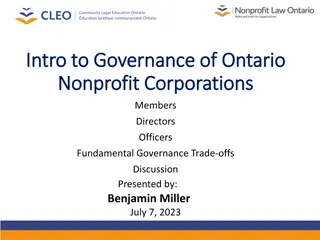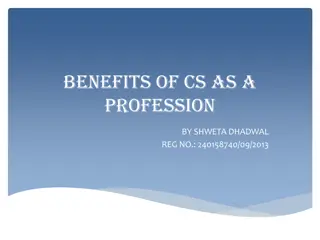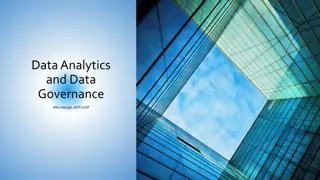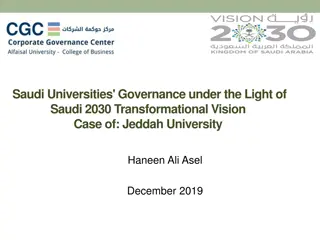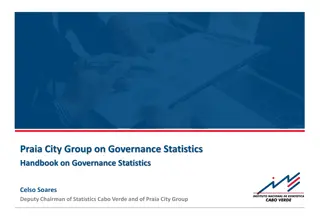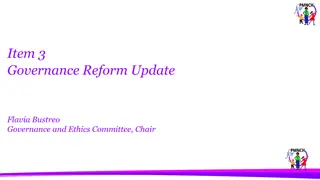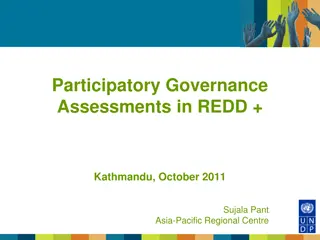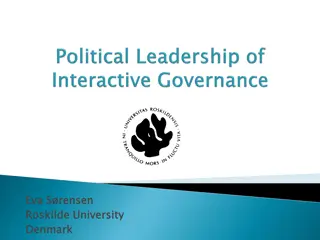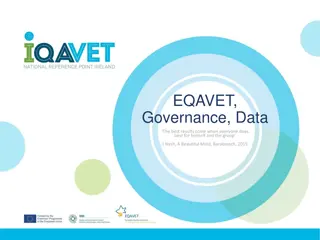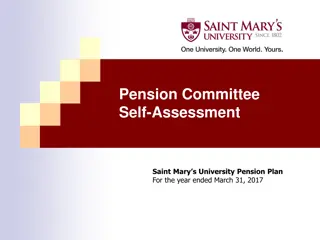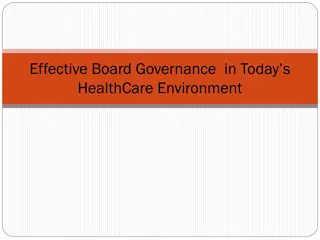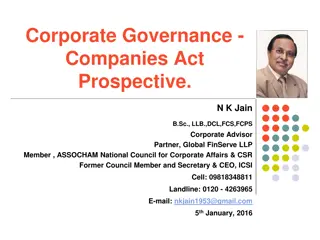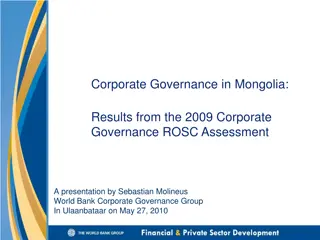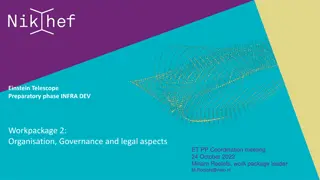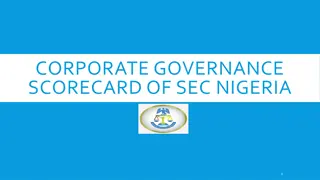Information Technology Governance and Services
Janet L. Vogel, Director of Office of Technology Solutions and Deputy CIO at Centers for Medicare & Medicaid Services, discusses IT governance bodies, guidance, processes, and the role of Information Technology Investment Review Board (ITIRB) in ensuring strategic alignment and maximizing ROI on IT investments.
Download Presentation

Please find below an Image/Link to download the presentation.
The content on the website is provided AS IS for your information and personal use only. It may not be sold, licensed, or shared on other websites without obtaining consent from the author.If you encounter any issues during the download, it is possible that the publisher has removed the file from their server.
You are allowed to download the files provided on this website for personal or commercial use, subject to the condition that they are used lawfully. All files are the property of their respective owners.
The content on the website is provided AS IS for your information and personal use only. It may not be sold, licensed, or shared on other websites without obtaining consent from the author.
E N D
Presentation Transcript
Information Technology Governance and Services Janet L. D. Vogel Director, Office of Technology Solutions, Deputy CIO Centers for Medicare & Medicaid Services Friday, October 30, 2015
CMS IT Program Support Foundational IT Support Technical Delivery Hosting Methodology Shared Services 2
Agenda Topics Examples of IT Governance Bodies, Guidance, and Processes IT Security Shared Services 3
IT Governance Information Technology Investment Review Board (ITIRB) Business Assessment Technical Review Board 4
Information Technology Investment Review Board (ITIRB) The CMS ITIRB is established as the executive review and decision-making body for CMS IT management. The ITIRB will review and approve IT initiatives and IT expenditures. The ITIRB will ensure that proposed investments contribute to the Secretary s strategic vision and mission requirements, meet the business needs of the agency, employ sound IT investment methodologies, comply with Departmental systems architectures, and provide the highest return on the investment or acceptable project risk. The ITIRB will ensure the agency s IT investments are positioned for success through guidance provided by the CMS TRB technical architecture standards to help ensure that the agency gets the most value out of its IT investments by maximizing opportunities for reuse and information sharing. The ITIRB will provide leadership and IT policy direction to ensure that the business drivers guide the agency s IT budget, operations, and development. The ITIRB will operate within the framework of the Agency s enterprise architecture, acquisition management requirements, capital planning requirements, and other administrative regulations. The ITIRB has the authority to plan, develop, and direct projects within the scope of their responsibility. The Clinger-Cohen Act requires that each agency undertake capital planning and investment control by establishing a process for maximizing the value and assessing and managing the risks of information technology acquisitions of the executive agency. 5
Information Technology Investment Review Board (ITIRB) The goal of the ITIRB is to promote integrated planning and collaboration among CMS programs, information technology systems, and business processes. Integration and collaboration will be facilitated through the ITIRB Executive Steering Committees (ESCs) and interaction with the Technical Review Board (TRB). The ESCs will review all IT investments from an enterprise perspective, prioritize IT investment requests using scoring criteria approved by the ITIRB, and prepare recommendations for the ITIRB. The TRB will review all IT projects as they progress through the IT Investment Life Cycle (ILC). The TRB will serve in an advisory capacity and make recommendations to the ITIRB and/or ESC, as appropriate. All matters brought to the ITIRB will be reviewed and documented through a formal capital planning and investment review process. The ITIRB will focus on high cost, high risk, and mission critical investments. An investment may meet any of the three criteria to be a candidate for full ITIRB review. The ESCs will review all investments and provide recommendations to the ITIRB. The ITIRB will rely on the recommendations of the ESCs for investments that don t meet these criteria. The ITIRB will reserve the right to perform a full review of any investment regardless of size, risk, and strategic value. 6
Business (BATS) The Business And Technology Solutions (BATS) Board supports the IT Investment Review Board (ITIRB) in managing the CMS IT portfolio. It is responsible for ensuring that IT budget decisions align with CMS business, financial and technical strategies. To help achieve this purpose, the BATS Board has the following objectives: Review IT budget requests as one unified enterprise IT portfolio. Provide the ITIRB with project-level funding recommendations during the IT budget formulation and execution phases. Revise for in-year adjustments, as necessary, during the IT budget formulation and execution phases. Provide project-level funding recommendations for unfunded IT projects based (i.e., Sweeps) Review performance of major IT investments (i.e., Operational Analysis, TechStat, PortfolioStat, etc.). 7
CMS Technical Review Board The Technical Review Board (TRB) is the CMS technical governance body for information technology (IT) projects that conducts system life cycle governance reviews and consultations. It provides guidance to project teams on adhering to CMS technical standards and leveraging existing technologies (e.g., Shared Services). In this role, the TRB provides the following benefits to the Agency: Provides lessons learned and best practices for IT projects and programs Helps to ensure that IT investments are positioned for success and adhere to the CMS architecture, standards, and guidance Helps to ensure that the Agency gets the most value out of its IT investments by maximizing opportunities for reuse and information sharing Contributes to leading edge discussions on business architecture Advocates for the strategic IT direction Promotes effective systems integration Provides consistent technical guidance to teams on how to implement their project/program in an efficient way Consultation XLC Review Consultations (also called consults) are discussions between the TRB and the project team that usually occur prior to formally engaging the Office of Technology Services (OTS); they are not official XLC reviews. The project team can request a consult at any time during the life cycle to discuss issues or seek the TRB s guidance. XLC reviews (also called gate reviews) are more structured than consultations. The TRB uses XLC reviews to discuss project implementation with the project team. The TRB is responsible for conducting several reviews identified in the XLC, including the Preliminary Design Review (Level 2 and 3 projects), the Detailed Design Review (Level 3 projects), and the Operational Readiness Review (Level 1, 2 and 3 projects). 8
Technical Review Board All of CMS Directly Benefits 9
CMS Technical Reference Architecture Framework for CMS s Architecture Standards & Best Practice Standardized Operating Environment Consistent Security Practices Interoperability and Reuse of Shared Infrastructure Required for IT Procurements/Contracts 10
TRB Process and Gateways Architecture Tech Standards Guidance TRA Other Standards & Guidance Review New Products & Technologies TRB Mission To help ensure that the agency s IT investments are positioned for success and adhere to the CMS architecture, standards, and guidance. Advisory Services for Technical SOWs Infrastructure Changes To ensure that the agency gets the most value out of its IT investments by maximizing opportunities for reuse and information sharing. Ad Hoc Inquiries Detailed Design Review (DDR) Operational Readiness Review (ORR) Post Preliminary Design Review (PDR) Arch In scope reviews for the TRB Disposition Review (DR) Architecture Review(AR) (BATS Review) Implementation Significant Changes Review (PIR) A d H o c C o n s u l t s System Development Projects Initiation Phase Concept Phase Planning Phase Rqmts Analysis Phase Design Phase Development Phase Test Phase O&M Phase Disposition Phase Implementation Phase Out of scope reviews for TRB Environment Readiness Review Project Baseline Review Investment Selection Review Annual Operational Analysis OTS Intake Requirements Review Security C&A 12
IT Security Key and critical to any IT activity in CMS Consider, also, the Privacy implications of any activity Data Guardians Program CIO Directive 15-01: o Requires CMS systems and applications to utilize strong authentication, also referred to as Multi- Factor Authentication (MFA), mechanisms for privileged user access in accordance with CMS security and privacy guidelines. 14
SCA/ATO Security Controls Assessment (SCA) & Authority To Operate (ATO) XLC (Development) Operations & Maintenance Security Controls Assessment (SCA) - All controls supporting the application and/or system are tested every three years by a third party vendor. And at least 1/3 of the controls are tested on a yearly basis. An Authority To Operate (ATO) will NOT be granted unless an SCA is performed, all controls tested and is signed off by the CMS Chief of Information Security Officer (CISO) Remember - Security assessments are not about checklists, simple pass-fail results, or generating paperwork to pass inspections or audits rather, they are the last line of defense in knowing the strengths and weaknesses of an organization s information system What is an ATO? - The ATO process is an essential part of the CMS enterprise-wide Information Security Program. It is used in making a risk determination decision for the operation of the subject system. When the level of risk to the CMS enterprise is deemed acceptable, the system is granted an ATO for up to three years.
Enterprise Shared Services IT shared services also complement other major federal IT initiatives laid out in OMB s December 2010 25-Point Implementation Plan to Reform Federal IT Management, including federal strategies for cloud computing, digital government, and enterprise architecture. 16 October 2015
What are Shared Services ? Shared services are the consolidation of business operations used by multiple parts of the same organization Shared services are cost-efficient because they centralize operations that are used by multiple components within the enterprise The goal of a shared services delivery model is to allow each component to focus limited resources on activities that support their goals Purpose is to shorten the time to market, reduce cost, improve interoperability, streamline communications, and provide standardization 17 October 2015
Summary of Available Shared Services CMS currently has five shared services, with additional services expected to be implemented. Master Data Management (MDM) service that synchronizes and links beneficiary, provider, and organizational data from different databases throughout the agency (Managed by OTS-EDSG) Business Rules Engine Services (BRES) service that expands agency-wide use and management of business rules (Managed by OTS-ESSG) Enterprise Portal a gateway allowing the public to access a number of systems related to Medicare Advantage, Prescription Drug, and other CMS programs (Managed by OTS-EDSG) Enterprise Eligibility Services provides a secure, consistent and re-usable way for applications to access beneficiary eligibility data (Managed by OTS-BAMG) Enterprise Identity Management (EIDM) helps to ensure individuals and organizations have secure, authorized access to a variety of CMS business applications (Managed by OTS-ESSG) 18 October 2015
What is Master Data Management at CMS? Master Data Management (MDM) is an enterprise infrastructure and associated processes for collecting, aggregating, matching, consolidating, quality-assuring, persisting and distributing Master Data throughout an organization to ensure consistency and control in the ongoing maintenance and use of this information. At CMS, MDM cross references and stores data obtained from CMS operational Systems of Record. MDM does not change source data, so MDM data can be considered to be as authoritative as the data is in the source System of Record from which it is obtained. Its primary areas of focus at CMS are to: Provide a trusted Identity Resolutioncapability for CMS expanding catalog of Master Data sources. Provide trusted Integration and Consolidation of Master Datafrom numerous disparate data sources to create a consolidated, authoritative view of each entity. Provide flexible and easy Access to Master Data(e.g., near real-time web services, extracts for batch processing, BI reporting, and real time portal access to BI tools through CMS Enterprise BI Environment). Promote the development of Enterprise Data Governance of Master Data Promote the improvement of data quality, integrity, and understanding (Data Stewardship) 19 3/12/2025
MDM Summary MDM does not change source system data, and will not replace program- specific SOR applications. MDM provides a Master Data Environment (MDE) for 4 Domains of CMS Data: 1. Beneficiaries 2. Providers 3. Organizations/Plans 4. Programs MDM provides a mechanism for consistently identifying, organizing, synchronizing, and easily accessing authoritative data across CMS. MDM is a standard methodology for accessing a comprehensive unified view of data across data repositories and systems. The MDM MDE contains: 1) MDM Enterprise Master Person Indexes (EMPI) that will provide identity resolution and linking using key data in each domain from multiple data sources 2) MDM Profiles and Relationships that will store domain-specific profiles and relationships between each data domain 3) MDM Data Access methods: Master Data Services (e.g., web services) MDM Data Extracts Business Intelligence (BI) Tools 20 October 2015
What is Enterprise Portal? Enterprise Portal is a Shared Service (Horizontal service) to support multiple business units (Vertical applications/projects) Provide a single point of access for users Provide authentication and minimum authorization mechanisms to vertical applications Integrated with Enterprise Identity Management (EIDM), Enterprise User Access, and Enterprise LDAP for authentication Users can use EUA, IACS and EIDM accounts Integrated with Business Intelligence Tools MicroStrategy, Cognos, SASEBI and Business Objects via OnePI Support 373,081 users and 33 business applications Customers include Professionals, providers, hospitals, issuers, Agent/Brokers, states, 21 October 2015
What Does Portal Deliver to Business? Support new vertical application integration into Enterprise portal Portal is deployed across CMS 3-Zone architecture and 508 compliant Portal UI is built as responsive web with web 2.0 technologies Detailed Integration Life Cycle Phases (refer to Portal Integration Life Cycle - PILC) Provide shared features for end users, application teams and developers Provide operations and maintenance support for applications post production Concurrent usage Splunk reports Maintenance pages Sev1 issues Support Application performance testing Load tests up to 9000 concurrent users at each data center that we will continue to fine tune and test. Continue to fine tune Portal infrastructure to meet higher loads Multi data center approach to minimize downtime for applications. 22 October 2015
What Is EIDM at CMS? EIDM is one of CMS enterprise shared services, along with: Enterprise Portal Master Data Management (MDM) Business Rules Enterprise Service (BRES) Enterprise Eligibility Service (EES) EIDM is the enterprise CMS identity and access management solution designed to protect the security of CMS data. EIDM ensures individuals are identity proofed and have secure, authorized access to CMS business applications. EIDM supports CMS goal to improve the user experience by providing an enterprise-wide set of credentials and simplified sign- on capability for multiple CMS applications. Page 23
EIDM Mission EIDM provides secure, reliable identity and access management services to CMS partners and customers to ensure the integrity of CMS programs and protect Agency information assets.To achieve the mission, the EIDM service provides 4 functions: User granted access by business application approver User registers to obtain a CMS credential Role selection Identity proofing Role approval MFA setup Establish a user ID Registration Authorization Self-Service User Credential Management Authentication User maintains their credential via self-service User signs into portal and accesses business application Login with user ID, password and 2nd factor Self-service management of roles, user ID, password and MFA Page 24
What is BRES? A business rule is a statement that describes a business policy or procedure The BRES service maintains business rules governance policies for creating and enhancing business rules. BRES provides software tools that can execute one or more business rules within CMS IT application code Business rules are rules that the business enacts, and has the power to revise or discontinue Business rules criteria: Rules support business policies and processes Rules are actionable (for example: If, then) For CMS, business rules could be applied in many business areas eligibility and enrollment, claims edit, pricing and payment, quality measures, fraud and abuse Eligibility Example: If Beneficiary is 65 then Beneficiary has reached age of Eligibility 25 October 2015
What Does BRES Deliver to Business? A tool for developing business rules Comprehensive support for developing, publishing, deploying, and/or integrating business rules Product Rule Development Tool (ODM) A place to build, store, and execute business rules Rule Support Infrastructure BRES Support Project Setup and Rule administration H/W & S/W Developing and integrating business rules for applications and services A process for developing and managing business rules Rule Rule Governance Development Procedures and Processes Enterprise or Business-specific Rules 26 October 2015
What is Enterprise Eligibility Services (ESS) ? An interoperable framework that will enable all CMS applications to access the correct systems of record for all eligibility-related data A secure, consistent and re-usable way for applications to access beneficiary eligibility data stored across multiple internal and external systems A component of a service-based application architecture 27 October 2015
What Does EES Deliver to Business? Provide consistent answers to eligibility inquiries Identify and use source-of-truth data Eliminate copies of data at multiple locations Develop once and use often Accessibility web service, or MQ message Realize economies of scale High availability, performance and throughput 28 October 2015
Questions? 29 October 2015



